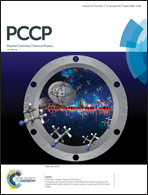N-terminal lipid conjugation of amyloid β(1–40) leads to the formation of highly ordered N-terminally extended fibrils†
Abstract
Fibril formation of amyloid β(1–40) (Aβ(1–40)) peptides N-terminally lipid modified with saturated octanoyl or palmitoyl lipid chains was investigated. Lipid modification of Aβ(1–40) significantly accelerates the fibrillation kinetics of the Aβ peptides as revealed by ThT fluorescence. Electron microscopy and X-ray diffraction results indicate a heterogeneous cross-β structure of the fibrils formed by the lipid-conjugated peptides. Solid-state NMR was used to investigate structural features of these fibrils. The lipid moieties form dynamic and loosely structured heterogeneous lipid assemblies as inferred from 2H NMR of the deuterated lipid chains. 13C NMR studies of selected isotopic labels reveals that in addition to Phe19 and Val39, which are part of the canonical cross-β structure, also N-terminal residues (Ala2, Phe4, Val12) are found in β-strand conformation. This suggests that the increased hydrophobicity induced by the lipid modification, alters the energy landscape rendering an N-terminal extension of the β-sheet structure favorable. Furthermore, the fibrils formed by the Aβ–lipid hybrids are much more rigid than wildtype Aβ fibrils as inferred from NMR order parameter measurements. Taken together, increasing the local hydrophobicity of the Aβ N-terminus results in highly ordered but heterogeneous amyloid fibrils with extended N-terminal β-sheet structure.



 Please wait while we load your content...
Please wait while we load your content...